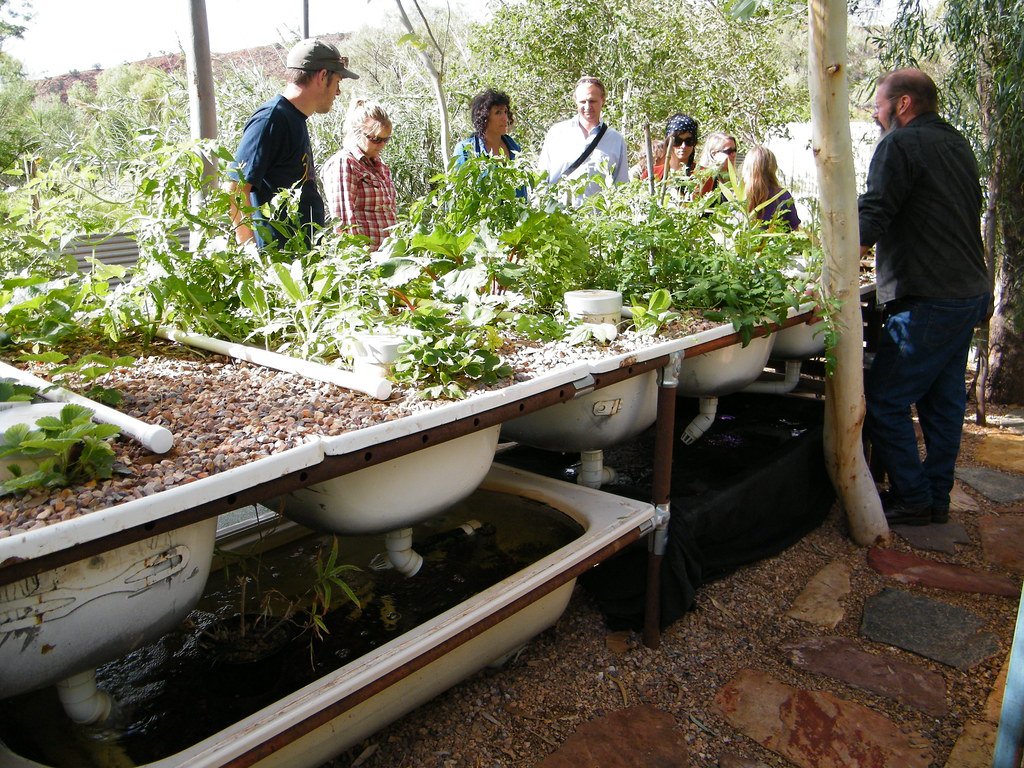Aquaponics is the combination of aquaculture and hydroponics. Aquaponics refers to a system of growing vegetables and keeping fish. In this farming system, the waste product from aquaculture is used in farming. Let us discuss some pros and cons of this type of farming.
Pros of Aquaponics
1. Environmental friendly: Aquaponics farming system does not rely on artificial fertilizers and other supplements. Manure and other waste products collected from the fishpond are instead used to add nutrients to the farm. This type of farming improves the productivity of the land and ensures the fish are not affected.
2. Good water-saving plan: This farming system requires little water for huge production. Unlike garden farming which requires many liters of water on a sunny day to sustain crops, in Aquaponics, water is greatly saved. Water from the fishpond is also used to irrigate the crops.
3. Space requirements: Do you have small-sized land you wish to cultivate? Aquaponics is the best farming method to choose. This farming can be done on small-scale farming, requiring little space. Most of hydroponics crops are short-leaved; therefore, they will occur in small sizes from one crop to another.
4. Cheap and affordable: Aquaponics is one of the cheapest and most affordable types of farming that one can start with little capital. Some of the Agri-based companies can help you install Aquaponics, and you must pay in installments. Setting the farming site and the fishing pond is not costly compared to large-scale farming of fish and vegetables.
5. Maintenance cost: The maintenance cost of Aquaponics is directly proportional to its initial cost. The cost of installation is lower than other modern methods of farming. In many institutions, the aquaponics installation practical is taught, increasing the number of technicians in this field. Due to the increased number of technicians, the installation cost is low and affordable. Similarly, this farming does not require much attention after being set up.
6. Income: In the current world, many people rely on farming as the main source of farming. Aquaponics is a good source of farming for farmers. The aquaculture and hydroponics products can be sold, increasing the farmer’s income. If the fish waste is excess, farmers can also sell it.
7. Can be placed anywhere: Aquaponics farming can be placed anywhere despite the size of the land. This type of farming is usually small-scale and requires less farming water. Therefore, due to this, it is easier and cheaper to set up the structure anywhere. In most cases, Aquaponics is installed near the market centers, which relieves farmers from transport expenses.
8. Aquaponics crops are healthier: Manure and waste from aquaculture supplement crops’ nutrients in Aquaponics. The waste product from aquaculture proves to be more nutritious than artificial fertilizers. It reduces the cases of organic manure-based diseases like cancer.
9. Little or no weeding: Weeds are the biggest threat to farming. Thankfully, Aquaponics is not greatly affected by weeds. The set-up is designed such that it does not support the growth of weeds. It saves farmers from expenses that would be used to buy herbicides.
10. Source of food: other than a source of income, the aquaponics product can supplement the farmer’s diet. They provide readily available food and fish meat.
11. Faster growth of crops: This type of farming is associated with faster growth of crops. Therefore, there is a continuous flow of market products.
Cons of Aquaponics
1. In some situations can be expensive: aquaponics farming requires water pumps, tanks, and pipes, thus in the case of a large scale, it may be expensive to install and maintain. The cost of purchasing fish is also higher.
2. Technical knowledge is required: Not all farmers can install and maintain the aquaponics structure. To install the aquaponics structure, trained personnel is required. After installation, the farmer has to be trained on how to handle the structure to maximize productivity.
3. Water problems: Areas experiencing water problems may not be appropriate to set up an aquaponics structure. Fishponds should regularly be supplied with water.
4. Not suitable for tuber crops: This farming system is only suitable for vegetable crops. It is because crops are grown of tubes, and thus there is a small root area.
5. Requires electricity: Electricity is required to maintain the temperature and pump water. The structure needs to be connected with power all the time, or else a massive loss would occur. It raises the electricity bill hence making this method of farming costly.
6. Installation cost: Many resources are required to establish an aquaponics structure. Therefore, it limits lower-class farmers from enjoying the benefits of Aquaponics.
7. Failure of the structure: All technical structures are prone to failure. In case of failure of the structure, massive losses occur. Fish are likely to die, and plants dry up.
8. Not widely accepted: This farming system is not adopted in all parts of the world. In many rural areas, they are not connected by electricity. Therefore, it is not possible to use this method of farming. Additionally, in low-income areas, the cost of construction may not be affordable.
9. Construction materials: Aquaponics construction materials are not readily available. As a result, it makes the process of construction difficult and costly. Additionally, the construction materials are prone to breakage. In some cases, the material has to be imported.
10. Diseases and pest attack: incase a disease affects the plants, all plants are likely to be affected. Pest and diseases hinder this type of farming and can easily cause losses to the farmer. If a contagious disease attacks the fishes in aquaculture, they are likely to die in large numbers.
11. Raising beds: In this type of farming, crops are grown on raised beds. Raising the bed may pose a great challenge to the farmer.
Therefore, this method of farming has numerous advantages and disadvantages.



